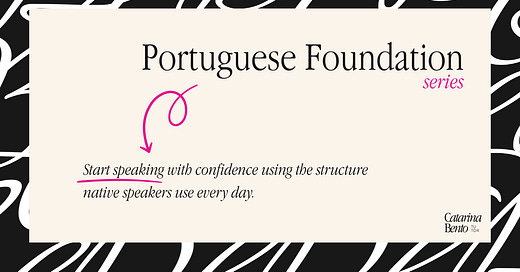What is the Portuguese Foundation Series?
The Portuguese Foundation Series is more than just a language course — it’s your launchpad into the world of European Portuguese.
Inside, you’ll learn how the language truly works: not just memorizing words, but unlocking the structure behind them so you can understand, speak, and grow your confidence from day one. We’ll guide you step by step through grammar, vocabulary, and real-life usage — with practical strategies that help you retain and apply what you learn far beyond the lessons.
Think of it as your shortcut to fluency — built to save you time, frustration, and guesswork. All we ask is that you show up, follow the guidance, and trust the process. The results will follow.
Who is this for?
Whether you’re an absolute beginner or someone who’s already dipped their toes into Portuguese but needs a stronger foundation — this course was made for you.
It’s ideal for:
Learners starting from scratch who want a clear, structured path
False beginners who want to clean up confusion and fill the gaps
Anyone who wants to speak Portuguese with clarity, confidence, and ease
This is your trial lesson — a chance to explore the method and see if it resonates with your learning style. If it feels like the right fit, you’re invited to unlock the full series by subscribing. Every week you’ll have a new lesson!
Lesson 1 - I am eating + Infinitives
In this lesson, you’ll learn how to talk about what you’re doing right now — in the present moment. But before we jump into it, there’s something essential we need to cover: the infinitive.
Infinitives
An infinitive is the base form of a verb — the version you’d find in the dictionary. It doesn’t carry any information about time (past, present, future) or person (I, you, they, etc). It’s neutral. Timeless. Pure potential.
In Portuguese, all infinitives end in a vowel + R. Here are a few examples:
comer – to eat
andar – to walk
partilhar – to share
partir – to break
This is the form we build from — and in this course, you’ll learn how to transform these raw forms into real, flowing Portuguese.
Task 1: Collect Your Verbs
Start by creating a list of verbs that reflect your daily actions — things you do often, things that are part of your routine.
You can use ChatGPT, DeepL, or an online dictionary to help, but keep this in mind:
⚠️ Some English verbs have multiple translations in Portuguese depending on context.
For example:
to run can mean correr (run physically) or gerir (to manage/run a business).
So if you’re unsure, don’t just look up the single word — try typing the whole sentence or describing the context. That will give you a much more accurate translation.
The Magic Formula:
Estar + a + Infinitive
Here’s where things get exciting.
This is the structure that unlocks your ability to start speaking Portuguese right now — in the present moment.
To use it, we need to start with the verb “estar”, which means “to be”. Once we know how to conjugate it, we can plug in any action and express what we’re doing — easily and naturally.
📚 Step 1: Conjugate “Estar”
Let’s go over the present tense forms of estar:
eu estou – I am
tu estás – you are (informal)
ele / ela / você está – he / she / you (formal) is
nós estamos – we are
vocês estão – you all are
eles / elas estão – they are
🧩 Step 2: Add the Infinitive
Now here’s how the structure works:
estar + a + infinitive = to be doing something
Let’s break this down with an example:
I want to say: I am eating
First, I find the correct form of “estar” → eu estou
Then, I take the infinitive “to eat” → comer
Put it together:
👉 Eu estou a comer – I am eating
That’s it.
You can do this with any verb and any subject:
Tu estás a andar – You are walking
Ela está a escrever – She is writing
Nós estamos a aprender – We are learning
It’s simple, powerful, and 100% real Portuguese — this isn’t a watered-down version. This is exactly how native speakers express actions happening right now.
Task 2: Speak It Into Reality
Take the verbs you collected earlier and start pairing them with different subjects (I, you, he, we, etc.).
Say each combination out loud — yes, even if it feels awkward at first.
Try to mix it up as much as possible:
Eu estou a estudar
Tu estás a cozinhar
Nós estamos a aprender…
The goal is to train your ear and your mouth to recognize the patterns and pronounce them naturally.
This step is where repetition turns into fluency — so speak boldly, speak often, and don’t be afraid to make mistakes.
You’re not just learning.
You’re becoming someone who uses Portuguese.
🎧 Listen & Practice
Now that you know how it works, listen to the audio to hear correct pronunciation and more real-life examples.
And if you have questions or want to practice with your own verbs, drop them in the comments below. This is your space to grow, ask, and get feedback.
Ready to Go Further?
If this lesson helped you understand and start speaking real Portuguese, imagine what you’ll be able to do with the full Foundation Series.
By subscribing, you’ll unlock:
✅ All current + future lessons
✅ Step-by-step guidance to speak naturally
✅ Listening practice, real examples, and member-only resources
✅ A method that actually works — and respects your time
Subscribe now to keep learning, growing, and turning Portuguese into your second skin. This is where your fluency begins.






Share this post